-
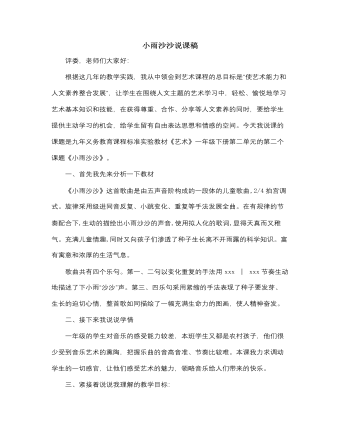
人音版小学音乐一年级下小雨沙沙说课稿
课堂小结部分,我设问“甘甜的雨露滋养种子,帮助种子成长,问学生们喜欢小雨吗?”学生回答后,我进一步诱导:“种子的生长离不开雨水的滋润,你们的成长离不开谁呢?”学生讨论回答(爸爸、妈妈、老师、祖国??)接着教导学生要热爱祖国,孝敬父母,尊敬老师。从现在做起,用优异的成绩来报答他们。 然后对学生这堂课的表现作一个简单的评价,伴随着音乐出教室。最后我总结一下我对这节课的理解和设计。新课改赋予了音乐课五彩缤纷的舞台,给学生的发展提供自由的空间,本课我充分发挥学生的主体作用,让学生成为课堂的主人,让学生在音乐中动起来,给课堂注入新鲜的"血液",让学生徜佯在音乐的世界里自由的发展,并体验到学习音乐的乐趣,真正快乐地享受音乐。 谢谢大家!
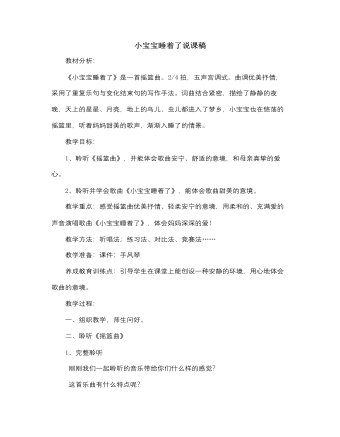
人音版小学音乐一年级下小宝宝睡着了说课稿
三、聆听、表演《小宝宝睡着了》 1、聆听歌曲启发学生说说听到歌曲时感受到了什么?2、复听,跟着歌曲,轻柔地拍节拍。 3、听琴声逐句学唱歌曲。 4、指导学生用连贯、轻柔的声音,唱准、唱好歌曲。 5、重点引导学生说说结尾的处理方式——对比练习,看哪一种方法更恰当 6、引导学生用自己创作的方式为歌曲伴奏、伴舞。 四、小结。 教学反思:一年级课堂上会有一些学生在上课的时候出现喊唱的现象,我在歌曲处理这一环节对歌曲的意境作了这样的描述:静静的夜晚,天上的星星睡了、月亮睡了、地上的鸟儿、虫儿也都进入了梦乡,小宝宝也在悠荡的摇篮里,听着妈妈甜美的歌声,渐渐入睡了。同学们妈妈哄宝宝睡觉唱歌的声音应该是欢快的,还是轻柔的?经过我的描绘和讲解学生理解了在演唱摇篮曲时应该用轻柔的声音,要把每一句都连贯的唱起来,不仅句与句之间要连贯,第一、第二段也要衔接紧凑,轻轻的哼唱出来,体会妈妈哄小宝宝睡觉时是多么的温柔。
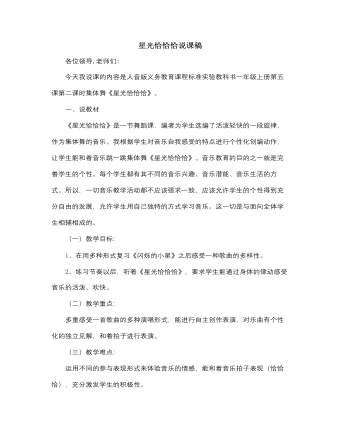
人音版小学音乐一年级下星光恰恰恰说课稿
为了进一步激发学生表演,我特意加上了舞蹈比赛这一环节, 每两小组分别表演,其他四个小组投票选择,选出优胜组,最后胜出的三个小组,再向大家展示。让学生多练多跳,激发起学生的参与意识.四、发展阶段让学生思考能变换什么队形,两人结伴或者几个人,学生自己编创组合队形。在本节课中,这个环节比较符合教学内容,通过自己的创作体验,学生就有了创新,有了突破,这就是创造性的体现,也是发展个性的体现.五、总结阶段本课我采用了归纳式的结尾,来归纳本课的教学内容,提出优点,缺点及改正方向.本课的课件为图文结合法,目的是激发情趣.,重点突出,一目了然,充分展现乐曲意境,让学生有身临其境之感.总之本课的设计考虑到了音乐学科的特点,课时的教学任务,学生的年龄特点等因素,运用各种教学媒体辅助教学,尤其是电脑媒体的介入,应该能使得课堂气氛活跃,让学生的学习兴趣,始终处于积极状态,充分体现了音乐、美术加以综合的审美育人功能.
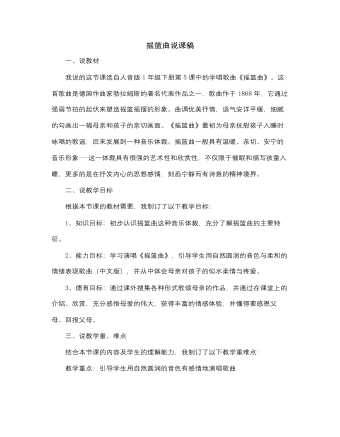
人音版小学音乐一年级下摇篮曲说课稿
先让学生小声跟音乐哼唱,找出自己觉得难唱的乐句以及歌曲中开头与结尾有什么特点。然后再用电子琴带动、结合老师动情的范唱、学生的讨论、尝试来解决歌曲的难点,找到最好的演唱效果。最后引导学生模枋母亲哄孩子睡觉的情景演唱歌曲,让学生在音乐气氛下体会到母亲与孩子的爱深深地融化在一起。3、课外拓展,升华情感。首先欣赏不同国家或民族的《摇篮曲》,揭示《摇篮曲》的音乐特征。通过欣赏不同的摇篮曲,让学生明白《摇篮曲》表达共同的主题,那就是母爱都是伟大的。再进一步了解歌曲的音乐特征。最后一个环节是请学生了解不同形式歌颂母爱的作品,请同学们谈一谈自己的感受。通过本环节教学,引导学生更进一步体会母爱的伟大,让学生用自己的话来表达对母亲的爱。并懂得要感恩父母、回报父母。很好的完成了本节课的德育目标。最后让学生带着对母亲的爱再一次演唱歌曲结束本课。

人音版小学音乐一年级下音的高低说课稿
(3)请学生用自己的声音模拟大钟、小钟,并按节奏谱读谱。(让学生通过歌谣中对大钟、小钟的声音长短的变化,体会大钟和小钟声音高低的特点。教师还要注意提示学生,在读歌谣过程中除了声音要模仿准确,节奏也要模仿准确。)(4)请学生选用乐器来模拟小钟的声音?(踫钟、三角铁)(5)老师用钢琴的低音模拟大钟的声音,其他同学按节奏读谱。教师要求:在教师与学生合作读节奏谱过程中,教师要提示学生:第一,心里要有节奏,速度不能忽快忽慢。第二,没有拿到乐器的同学在读谱过程中,不要忘记模拟大钟、小钟声音的高低。(6)教师与学生合作共同读谱并用乐器模拟大钟、小钟声音。三、课堂小结声音的世界真神奇,有了高低不同、音色不同的神奇声音,把我们的生活装扮得很有趣。今天,我们了解了用“高”、“低”来分辨声音的音色特点。老师给同学们留一个作业,请你试着用声音高低不同的乐器或是动物来创编新歌谣的歌词。
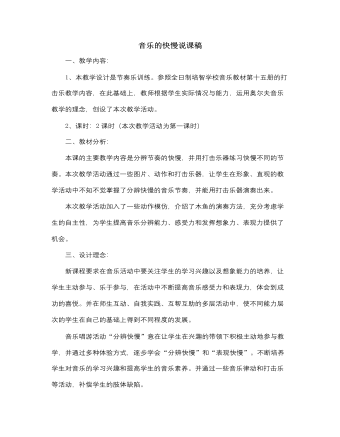
人音版小学音乐一年级下音乐的快慢说课稿
3、用木鱼来演奏音乐的不同节奏。(1)师:小动物们都能听着音乐按节奏走路了,下面我想考考你们能不能用这种乐器来演奏不同的节奏呢。(2) 出示木鱼,演示木鱼的演奏方法。师:左手拿木鱼,右手拿木棍,敲的时候要注意不要打在自己的手指上,打在手指上是没有声音的。(3) 玩游戏《听一听》,训练学生的听辨能力和记忆能力。师:我们先来玩一个游戏,老师敲出几个不同的节奏,你们听听哪个是最慢的,哪个是最快的,看谁的耳朵最灵敏。(4) 学生练习演奏木鱼,学会用木鱼敲出不同的节奏,教师个别指导。师:现在就请同学们自己来演奏木鱼,你可以尝试着怎样敲会快一点,怎样会慢一点。(木鱼学生人手一个)[设计思路]在分层教学过程中,由于个别学生的基础比较差,第一和第二段音乐的演奏训练还不能完全掌握,所以花的时间比较长。导致接下的第三和第四段音乐的木鱼节奏训练没有时间完成。我将在第二课时的复习巩固课上再让同学们来练习演奏。
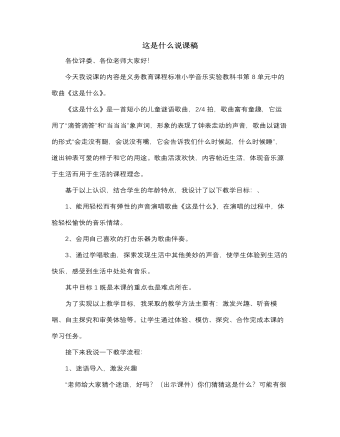
人音版小学音乐一年级下这是什么说课稿
新课标指出,在教学中应注意培养学生自信的演唱,演奏能力及综合性艺术表演能力。我通过举办小小音乐会,把学生分成乐器组和表演组,乐器组的同学使用打击乐为歌曲伴奏,表演组的同学即兴创编动作,让学生在歌表演伴奏教学活动中鼓励学生大胆模仿、想象,培养学生即兴表演能力和人与人这间的合作精神,并让学生在活动中享受美的愉悦,受到情感陶冶,从而把课堂推向高潮。4、深化主题,拓展视野为了拓展学生的音乐视野,深化课堂,我鼓励学生探索和发现生活中其它美妙的声音,(出示课件)“闹钟是我们身边的好朋友,你身边还有哪些能发出响声的好朋友呢?你能不能把他们也变成音乐唱出来呢?”这样让学生感受到生活中处处有音乐,并且挖掘了教材的真正意图,体现音乐课的真正价值。孩子们在歌声中结束了本课的学习,意犹未尽。
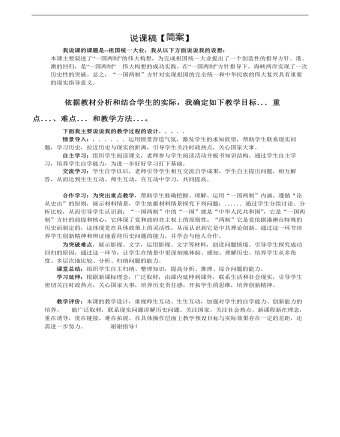
高中历史人教版必修一《第22课祖国统一大业(简案)》说课稿
情景导入:......运用情景营造气氛,激发学生的求知欲望,帮助学生联系现实问题,学习历史,拉近历史与现实的距离,引导学生关注时政热点,关心国家大事。自主学习:组织学生阅读课文,老师参与学生阅读活动并板书知识结构。通过学生自主学习,培养学生自学能力,为进一步好好学习打下基础。交流学习:学生自学以后,老师引导学生相互交流自学成果,学生自主提出问题,相互解答,从而达到生生互动、师生互动,在互动中学习,共同提高
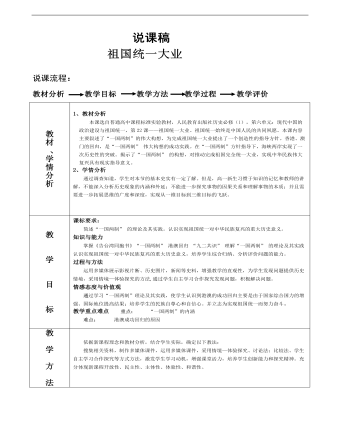
高中历史人教版必修一《第22课祖国统一大业》说课稿
1、教材分析 本课选自普通高中课程标准实验教材,人民教育出版社历史必修(1),第六单元:现代中国的政治建设与祖国统一,第22课——祖国统一大业。祖国统一始终是中国人民的共同夙愿。本课内容主要叙述了“一国两制”的伟大构想,为完成祖国统一大业提出了一个创造性的指导方针。香港、澳门的回归,是“一国两制” 伟大构想的成功实践。在“一国两制”方针指导下,海峡两岸实现了一次历史性的突破。揭示了“一国两制” 的构想,对推动完成祖国完全统一大业,实现中华民族伟大复兴具有现实指导意义。 2、学情分析通过调查知道,学生对本节的基本史实有一定了解。但是,高一新生习惯于知识的记忆和教师的讲解,不能深入分析历史现象的内涵和外延;不能进一步探究事物的因果关系和理解事物的本质;并且需要进一步拓展思维的广度和深度,实现从一维目标到三维目标的飞跃。
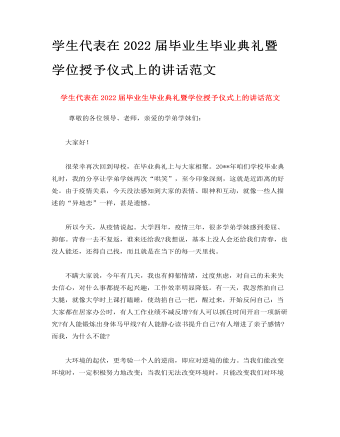
学生代表在2023届毕业生毕业典礼暨学位授予仪式上的讲话范文
所以今天,从疫情说起。大学四年,疫情三年,很多学弟学妹感到委屈、抑郁。青春一去不复返,谁来还给我?我想说,基本上没人会还给我们青春,也没人能还,还得自己找,而且就是在当下的每一天里找。 不瞒大家说,今年有几天,我也有抑郁情绪,过度焦虑,对自己的未来失去信心,对什么事都提不起兴趣,工作效率明显降低。有一天,我忽然拍自己大腿,就像大学时上课打瞌睡,使劲掐自己一把,醒过来,开始反问自己:当大家都在居家办公时,有人工作业绩不减反增?有人可以抓住时间开启一项新研究?有人能锻炼出身体马甲线?有人能静心读书提升自己?有人增进了亲子感情?而我,为什么不能?
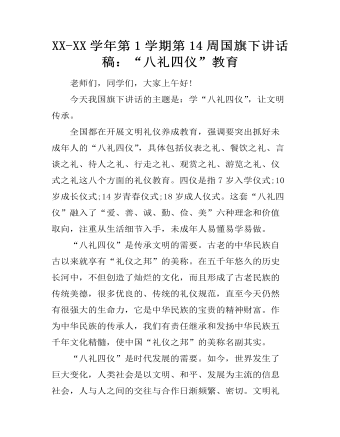
XX-XX学年第1学期第14周国旗下讲话稿:“八礼四仪”教育
老师们,同学们,大家上午好!今天我国旗下讲话的主题是:学“八礼四仪”,让文明传承。全国都在开展文明礼仪养成教育,强调要突出抓好未成年人的“八礼四仪”,具体包括仪表之礼、餐饮之礼、言谈之礼、待人之礼、行走之礼、观赏之礼、游览之礼、仪式之礼这八个方面的礼仪教育。四仪是指7岁入学仪式;10岁成长仪式;14岁青春仪式;18岁成人仪式。这套“八礼四仪”融入了“爱、善、诚、勤、俭、美”六种理念和价值取向,注重从生活细节入手,未成年人易懂易学易做。“八礼四仪”是传承文明的需要。古老的中华民族自古以来就享有“礼仪之邦”的美称。在五千年悠久的历史长河中,不但创造了灿烂的文化,而且形成了古老民族的传统美德,很多优良的、传统的礼仪规范,直至今天仍然有很强大的生命力,它是中华民族的宝贵的精神财富。

主题教育总结常用提纲大全
第一,主题教育是一次思想作风的深刻洗礼,初心传统进一步得到回归。第二,主题教育是一次沉疴积弊的集中清扫,突出问题进一步得到整治。第三,主题教育是一次强化为民服务的生动实践,赤子之情进一步得到提振。第四,主题教育是一次激发创业担当的有利契机,发展层次进一步得到提升。2.第一,必须提领思想、武装思想。第二,必须聚焦问题、由表及里。第三,必须领导带头、以上率下。第四,必须务实求实、认真较真。3.一是抬高政治站位,坚持大事大抓。二是坚持思想领先,狠抓学习教育。三是突出问题导向,深入整改纠治。四是坚持领导带头,发挥表率作用。4.一是立足“早”字抓筹划。二是着眼“活”字抓学习。三是围绕“统”字抓协调。5.一是形势所需。二是任务所系。三是职责所在。四是制度所定。6.一要提升认识。二要积极作为。三要密切协作。
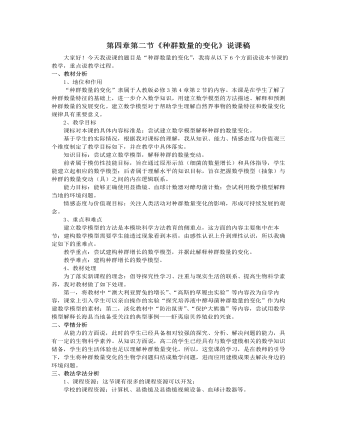
人教版高中生物必修3第四章第二节《种群数量的变化》说课稿
4、种群数量变化的其他类型我结合“种群数量下降”这个知识点对学生进行寓教。现今的自然界,许多野生生物种群的数量都在下降,为什么呢?我提供了世界人口近2000年的种群增长曲线,一切都在不言而喻中。现今社会的主题是呼吁建立和谐社会,作为生物老师,我想它不应该仅仅指人与人之间的和谐,也不应该仅仅指人与社会之间的和谐,它更应该昭示着人与自然之间的和谐,人类只有学会与自然和谐相处,才能在生物圈中享受最大的幸福。6、小结课程在实验的大背景下展开,也在实验的背景中结束,这里可以呈现出一个完整的探究思路。同时,学生思考如何实现多种预期过程,相当于对本课进行小结。五、效果预测课堂上选取的内容基于学生的生活体验,创设的情境能激发学生的兴趣,设置的问题符合学生的认知水平,有助于学生能力的提高,教学目标可以基本实现。
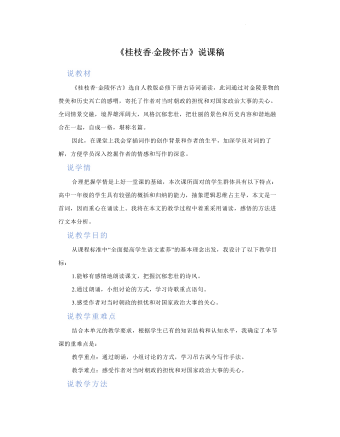
古诗词诵读《桂枝香?金陵怀古》说课稿(一) 2021-2022学年统编版高中语文必修下册
王安石,字介甫,号半山。北宋著名政治家、思想家、文学家、改革家,唐宋八大家之一。欧阳修称赞王安石:“翰林风月三千首,吏部文章二百年。老去自怜心尚在,后来谁与子争先。”传世文集有《王临川集》、《临川集拾遗》等。其诗文各体兼擅,词虽不多,但亦擅长,世人哄传之诗句莫过于《泊船瓜洲》中的“春风又绿江南岸,明月何时照我还。”且有名作《桂枝香》等。介绍之后设置这样的导入语:今天我们共同走进王安石,一起欣赏名作《桂枝香·金陵怀古》。(板书标题)(二)整体感知整体感知是赏析文章的前提,通过初读,可以使学生初步了解将要学到的基本内容,了解文章大意及思想意图,使学生对课文内容形成整体感知。首先,我会让学生根据课前预习,出声诵读课文,同时注意朗读的快慢、停顿、语调、轻重音等,然后再播放音频,纠正他们的读音与停顿。其次,我会引导学生谈谈他感受。学生通过朗读,能够说出本词雄壮、豪放、有气势,有对景物的赞美和对历史的感喟。
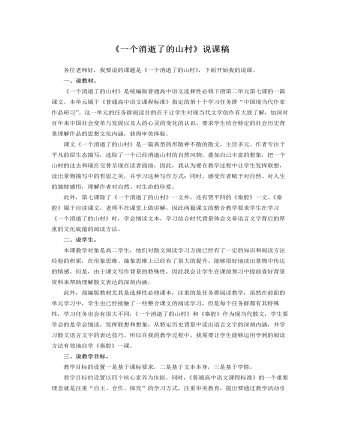
《一个消逝了的山村》说课稿 2021—2022学年统编版高中语文选择性必修下册
这几段内容传达出的是“要敬畏生命,尊重生命;更要敬畏大自然,尊重大自然,爱护大自然”的主旨内涵,因此让学生通过自由朗读的方式,再次体会冯至对这个消逝了的山村的细致的美好的描绘,感悟冯至传达出的对生命,对自然的理解和思考。5.最后一个自然段的解读依然是交给学生,先齐读课文,再让学生自主分享自己的体会或疑惑。但在这一环节我也设计了两个我认为必须解答的两个问题,一是怎么理解“在风雨如晦的时刻”;二是“意味不尽的关联”是指什么。我认为这两个问题一个涉及到写作背景,一个涉及到对全文主旨的一个整体把握,能够进一步帮助学生理解散文的深刻内涵和主旨,让学生有意识的在阅读散文过程中通过背景知识进行理解。既尊重学生的个性化解读,又能够让学生有意义学习,完成预设的教学目标。如果学生没有提到这两处,那我就需要做出补充。

新人教版高中英语必修3Unit 1 Festivals and celebrations-Discovering Useful Structure教学设计
4.That was an experience that frightened everyone. →That was _____________________. 答案:1. taking 2. being discussed 3. in the reading room 4. a frightening experienceStep 6 The meaning and function of V-ing as the predicative动词-ing形式作表语,它通常位于系动词后面,用以说明主语“是什么”或“怎么样”一种表示主语的特质、特征和状态, 其作用相当于形容词; 另一种具体说明主语的内容, 即主语等同于表语, 两者可互换。The music they are playing sounds so exciting. 他们演奏的音乐听起来令人激动。The result is disappointing. 结果令人失望。Our job is playing all kinds of music. 我们的工作就是演奏各种音乐。Seeing is believing. 眼见为实。Step 7 Practice1. It is ________(amaze) that the boy is able to solve the problem so quickly.2. Buying a car is simply _______(waste) money. 3. Please stop making the noise—it’s getting ________(annoy). 4. complete the passage with the appropriate -ing form.La Tomatina is a festival that takes place in the Spanish town Bunol every August. I think many food festivals are __________ because people are just eating. however, this festival is _________ because people don't actually eat the tomatoes. Instead, they throw them at each other! the number of people ________ part in this tomato fight, can reach up to 20,000, and it is a very __________ fight that lasts for a whole hour. The _______ thing is how clean Bunol is after the tomatoes are washed away after the fight. this is because the juice form tomatoes is really good for making surfaces clean!答案:1. amazing 2. wasting 3. annoying4. boring interesting taking exciting amazing

新人教版高中英语必修3Unit 1 Festivals and Celebrations-Reading and Thinking教学设计
The topic of this part is “Discover the reasons for festivals and celebrations.The Listening & Speaking & Talking part aims at talking about the experiences and feelings or emotions about the festivals and celebrations. This section aims at detecting the reason why the people celebrate the festivals, the time, the places, the types and the way of celebrations. It also explains why some traditions in the old celebrations are disappearing, like the firecrackers in the big cities and some new things are appearing like the prosperity of business or commerce. 1. Students can talk about what festivals they know and the reasons and the way of celebrating them.2. Students should learn the reading skills such as the headline and get the topic sentences, the structures of articles.3. Students can understand the past, the present situation of some festival around the world and why there are some changes about them. 4. Students can have the international awareness about the festivals.1. Students should learn the reading skills such as the headline and get the topic sentences, the structures of articles.2. Students can understand the past, the present situation of some festival around the world and why there are some changes about them.Step 1 Lead in---Small talkWhat festival do you like best ? Why ?I like the Spring Festivals because I can set off the fireworks, receive the lucky money and enjoy the Gala with my families.Step 2 Before reading---Pair workWhy do people celebrate different festivals ?The Spring Festivals is to celebrate the end of winter and the coming of spring and new life.The Mid-autumn Day is to celebrate the harvest and admire the moon.

新人教版高中英语必修3Unit 1 Festivals and Celebrations-Listening &Speaking&Talking教学设计
The theme of this section is “Talk about festival activities and festival experiences”.Festival and holiday is a relaxing and interesting topic for students. This part talks about the topic from the daily life of students’. In the part A ---Listening and Speaking, there are three conversations among different speakers from three countries(Japan, Rio and China), where the speakers are participating in or going to participate in the festivals and celebrations. So listening for the relationship among them is a fundamental task. Actually, with the globalization and more international communication, it is normal for Chinese or foreigners to witness different festivals and celebrations in or out of China. In the Conversation 1, a foreign reporter is interviewing a Japanese young girl who just had participated in the ceremony of the Coming-of-Age Day on the street and asking her feeling about the ceremony and the afterwards activities. Conversation 2, Chinese girl Li Mei is witnessing the Rio Carnival for the first time, and her friend Carla gives her some advice on the costumes which enables her to match with the carnival to have a good time. Conversation 3, a Chinese guide is showing a group of foreign visitors around the Lantern Festival and introducing the customs of the festival to them. The three conversations have a strong vitality and insert the festival and cultural elements from different countries. So perceiving the festivals and cultures from different countries is the second task. At the same time, the scripts also insert the targeted grammar --- v-ing as attributive and predicative, which students can perceive and experience in a real context and make a road for the further study. That is the third task. In the Part B--- Listening and Talking, the theme is “Talk about festival experience”, which is the common topic in our daily conversations. During the conversation, Song Lin, a Chinese student, asked Canadian friend Max about how to spend Christmas. In the conversation, Song Lin talked about experience and the feelings during the Chinese Spring Festival, during which there are not only some enjoyable things but some unpleasant things. After the listening, perhaps students find there are some similarities between Christmas and the Chinese Spring Festival as there are some differences in the origins and celebrations. For example, people always visit friends and relatives, decorate their houses, have a big dinner together, chat and give presents to each other.

新人教版高中英语选修2Unit 1 Science and Scientists-Discovering useful structures教学设计
The grammatical structure of this unit is predicative clause. Like object clause and subject clause, predicative clause is one of Nominal Clauses. The leading words of predicative clauses are that, what, how, what, where, as if, because, etc.The design of teaching activities aims to guide students to perceive the structural features of predicative clauses and think about their ideographic functions. Beyond that, students should be guided to use this grammar in the context apporpriately and flexibly.1. Enable the Ss to master the usage of the predicative clauses in this unit.2. Enable the Ss to use the predicative patterns flexibly.3. Train the Ss to apply some skills by doing the relevant exercises.1.Guide students to perceive the structural features of predicative clauses and think about their ideographic functions.2.Strengthen students' ability of using predicative clauses in context, but also cultivate their ability of text analysis and logical reasoning competence.Step1: Underline all the examples in the reading passage, where noun clauses are used as the predicative. Then state their meaning and functions.1) One theory was that bad air caused the disease.2) Another theory was that cholera was caused by an infection from germs in food or water.3) The truth was that the water from the Broad Street had been infected by waste.Sum up the rules of grammar:1. 以上黑体部分在句中作表语。2. 句1、2、3中的that在从句中不作成分,只起连接作用。 Step2: Review the basic components of predicative clauses1.Definition

新人教版高中英语选修2Unit 1 Science and Scientists-Learning about Language教学设计
Step 7: complete the discourse according to the grammar rules.Cholera used to be one of the most 1.__________ (fear) diseases in the world. In the early 19th century, _2_________ an outbreak of cholera hit Europe, millions of people died. But neither its cause, 3__________ its cure was understood. A British doctor, John Snow, wanted to solve the problem and he knew that cholera would not be controlled _4_________ its cause was found. In general, there were two contradictory theories 5 __________ explained how cholera spread. The first suggested that bad air caused the disease. The second was that cholera was caused by an _6_________(infect) from germs in food or water. John Snow thought that the second theory was correct but he needed proof. So when another outbreak of cholera hit London in 1854, he began to investigate. Later, with all the evidence he _7_________ (gather), John Snow was able to announce that the pump water carried cholera germs. Therefore, he had the handle of the pump _8_________ (remove) so that it couldn't be used. Through his intervention,the disease was stopped in its tracks. What is more, John Snow found that some companies sold water from the River Thames that __9__________________ (pollute) by raw waste. The people who drank this water were much more likely _10_________ (get) cholera than those who drank pure or boiled water. Through John Snow's efforts, the _11_________ (threaten) of cholera around the world saw a substantial increase. Keys: 1.feared 2.when 3. nor 4.unless 5.that/which 6.infection 7.had gathered 8.removed 9.was polluted 10.to get 11. threat


